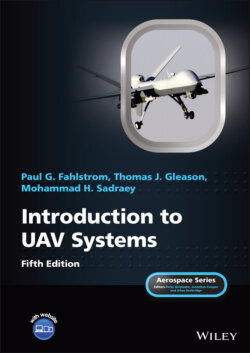Читать книгу Introduction to UAV Systems - Mohammad H. Sadraey - Страница 83
Questions
Оглавление1 Define aerodynamics.
2 Name primary forces that act on an air vehicle.
3 Name elements that make considerable contributions on air vehicle’s aerodynamic features.
4 What is the primary aerodynamic function of a wing?
5 Name two aerodynamic forces.
6 The aerodynamic forces of lift and drag are functions of a number of factors. What are they?
7 Define lift.
8 Draw the side‐view of a wing at an angle of attack. In the figure, illustrate: (1) total aerodynamic force, (2) lift, (3) drag, and (4) name and the location of the forces.
9 Define Mach number.
10 List the flight regimes, when the airspeed is compared with the speed of sound. Briefly define each one.
11 What are the two most important parameters of an airfoil?
12 Provide at least five geometric parameters of an airfoil.
13 Briefly compare the patterns of air pressure over a two‐dimensional airfoil and a three‐dimensional wing.
14 What do NACA and NASA stand for?
15 Define streamline.
16 What is the thickness‐to‐chord ratio of the NACA airfoil 23021?
17 What is the lift coefficient of the NACA 23021 airfoil at an angle of attack of 10 degrees when R = 3 × 106?
18 What is the maximum lift coefficient of the NACA 23021 airfoil when R = 3×106?
19 What is the minimum drag coefficient of the NACA 23021 airfoil when R = 8.9 × 106?
20 What is the drag coefficient of the NACA 23021 airfoil when the lift coefficient is 0.2 at R = 8.9 × 106?
21 What airfoil is used on the wing of the Northrop Grumman RQ‐4 Global Hawk?
22 What airfoil is used on the wing of the General Atomics MQ‐1 Predator?
23 Compare the static pressure of the top and bottom surfaces for a positive cambered airfoil at a positive angle of attack. Draw a figure.
24 Why is a vortex generated at each wing tip?
25 Briefly describe how the lift is generated on a wing.
26 Draw a typical drag polar and discuss its characteristics.
27 The drag coefficient is the sum of two terms. What are they?
28 Write the drag polar equation.
29 Define aspect ratio.
30 Discuss how to convert the “infinite wing” (i.e., airfoil) lift coefficient to the lift coefficient of a real wing.
31 What is the most important element of drag introduced by a wing at high angles of attack?
32 What is the significance of an elliptical lift distribution over the wing? Discuss.
33 What can be concluded from Equation (3.9) about induced drag?
34 Discuss characteristics of the boundary layer of a fluid flowing over a surface.
35 Name three regions of the boundary layer.
36 How is mathematically Reynolds number expressed?
37 What is the typical Reynolds number for small UAVs?
38 What is the typical Reynolds number for large subsonic UAVs?
39 What is the typical Reynolds number for Quadcopters?
40 What is the relation between static pressure and dynamic pressure for an incompressible flow?
41 What can be concluded from Bernoulli’s equation for variations of pressure and flow speed?
42 Discuss when a flow separation happens inside a duct. What is the consequence of flow separation?
43 What do CDo and CDi stand for?
44 What are two major contributors to CDo of a fixed‐wing conventional air vehicle?
45 What are two components of the net aerodynamic force generated by the relative wind in a flapping wing? Show them in a figure.
46 Briefly compare the lift at the wingtip of: (1) a flapping wing and (2) a fixed‐wing of a conventional air vehicle.
47 Briefly compare the aerodynamic outcome at the wing tip and the wing root of a flapping wing.
48 Compare the angle of attack variation which is “selected” by a bird during an up and down stroke.
49 What factors impact the air vehicle maximum aerodynamic efficiency?
50 A HALE UAV with a wing area of 74 m2 and the following feature is cruising with an airspeed of 400 km/h at an altitude that the air density is 0.3 kg/m3:K = 0.043, CDo = 0.026, CL = 0.25Determine the air vehicle drag at this flight condition.
51 A MALE UAV with a turbofan engine has a zero‐lift drag coefficient of 0.024 and an induced drag factor of 0.05. Determine the maximum aerodynamic efficiency of the air vehicle.
52 A mini‐UAV with a wing area of 1.2 m2 is cruising with an airspeed of 20 m/s at an altitude where the air density is 1.1 kg/m3. The UAV has the following features:CDi = 0.005, CDo = 0.026Determine the air vehicle drag for this flight condition.
53 A small UAV with a wing area of 6.5 m2 is cruising with an airspeed of 50 m/s at an altitude where the air density is 0.92 kg/m3. The UAV has the following features:CDi = 0.008, CDo = 0.028Determine the air vehicle drag for this flight condition.
54 What is the wing aspect ratio for the General Atomics MQ‐1 Predator?
55 What is the wing aspect ratio for the Northrop Grumman RQ‐4 Global Hawk?
56 What is the wing aspect ratio for the AeroVironment RQ‐11 Raven?
57 Describe aerodynamic features of the ScanEagle.
